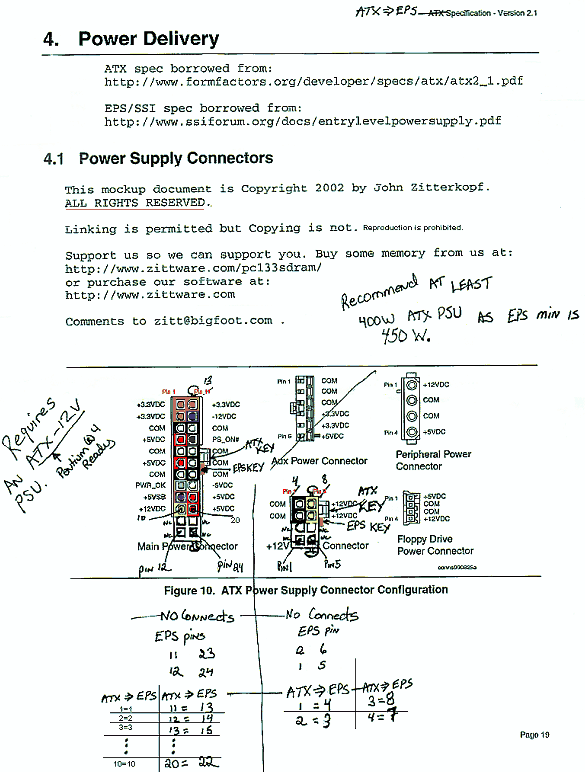Using ATX PSUs with
EPS / SSI Motherboards.
Standard ATX 12V
(Pentium (R) 4 ready) power supplies (PSUs) can be used
to power SSI motherboards. Officially SSI motherboards require an EPS-12V
PSU to power the motherboard. Normally, getting a new powersupply isn't a
problem; but in this case EPS PSUs are expensive even if you can find a source.
At the time this tutorial was written, no known online stores carry EPS PSUs.
Luckily, This tutorial will show you how to use a standard
ATX-12V psu with your new SSI motherboard. First some ground rules:
-
Use this tutorial at your own risk. While the author's
computer is configured this way; it is not to spec and may have long
term repercussions. The author cannot be held responsible for misuse or
damage resulting from this tutorials use.
-
This tutorial is Copyright 2002 by John Zitterkopf. Linking
to this WWW page is permitted; but reproduction in any form is not permitted
without written permission. Do not link directly to the GIF image. Instead
link to this page. You may print this tutorial/GIF for *personal*
use / reference; but do not reproduce it.
-
This tutorial is made possible from the generous support of
our customers. Please consider purchasing
some memory from us or purchase
some software developed by our company.
-
This tutorial requires an ATX-12V PSU. The -12V means it has
a 4pin (2x2) connector which contains 12V and ground connections. These
connections are usually used to power recent the voltage regulator for Intel
Pentium (r) 4 processors.
-
The ATX PSU needs to be a high quality PSU
capable of at
least 400W. Wattage less than 400W may not adequately power dual CPU
configurations. Remember that the EPS-12V spec starts out at 450W; so
skimping on low wattage or low quality PSUs may prevent success in
implementing this tutorial.
Now that the ground rules have been set; lets get to work.
Below you will find a color .GIF file which is a red-lined
copy of p.19 of the ATX
Specification, V2.1 . This mockup of page 19 has been color coded to
show the color of the ATX wires and show how to connect the ATX power
connectors. Here is a textual description of the data contained in the .GIF
file.
-
Note that the ATX connectors will plug into the SSI power
connectors; but the "latching" key will not line up to the EPS Key
post. Latching key and post will be on the same side of the two connectors;
they just won't line up.
-
Do not use excessive force to seat the connectors into the
motherboard. The connectors fit properly like a normal connector. I do not believe
there is a way to plug the connectors in improperly (IE backward); however,
care must be taken to properly apply this tutorial.
-
The ATX 20-pin main power connector will line up in the top
20 pins of the SSI motherboard connector... leaving 4 unconnected pins (11,
12, 23, and 24). On the author's motherboard; the unconnected pins are not
an issue as they are tied to the other power plains of a standard ATX power
connector.
-
The ATX-12V 4-pin connector plugs into pins 3,4 and 7,8 of
the EPS 8-pin connector. Pins 1,2 and 5,6 are unconnected. On the author's
motherboard, the +12V signals (5,6,7,8) are tied to the same motherboard
power plane. The GND signals (1,2,3,4) are also tied to the same ground
plane.
-
Peripheral and floppy power connectors are unmodified and
are used as-is.
-
Note that no rework / soldering is necessary use an ATX PSU
with a SSI motherboard. The connection are possible because the SSI / EPS
spec is simply an "extension" of the older ATX specification.

Figure 1: ATX to EPS / SSI power connections
(Click this picture to have it enlarge to full size for easier readability.)
That's about all you need to know. Armed with the information above; you should
be able to power a motherboard designed to the SSI spec using a regular
off-the-shelf ATX12V Power supply.
Please feel free to leave us comments or improvement suggestions for this
tutorial at no_spam@zittware.com.
While your here; Check out our other tutorials which may be of interest to you.
|
